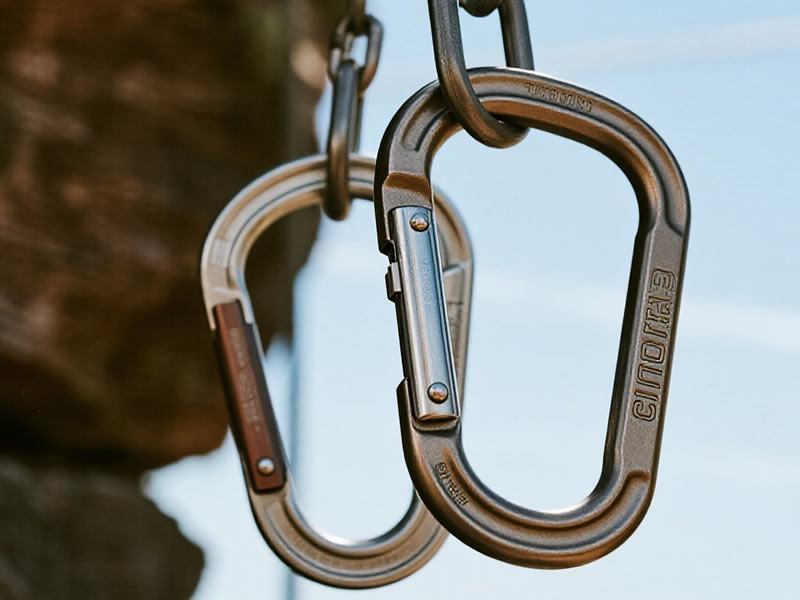Small Steel vs Aluminum Carabiner: Choosing the Right Tool for Your Load
When selecting a carabiner, especially a smaller one for critical applications, the steel vs aluminum debate is fundamental. Both materials excel, but understanding their core differences – strength, weight, durability, and cost – ensures you make the safest, most efficient choice.

The Case for Steel Carabiners
- Unmatched Strength & Durability: Small steel carabiners boast superior tensile strength and incredible resistance to abrasion, wear, and deformation. They shrug off rough surfaces like rock edges or metal fixtures far better than aluminum.
- Superior Handling Under Load: Steel is less prone to "gate flutter" (inadvertent opening) under high shock loads due to its mass and gate spring characteristics.
- Long-Term Value: While heavier and often more expensive initially, steel's exceptional durability makes it cost-effective over time, especially in high-wear environments (industrial rigging, fixed anchors, rescue, frequent top-rope setups).
The Case for Aluminum Carabiners
- Critical Weight Savings: This is aluminum's prime advantage. Small aluminum carabiners weigh roughly one-third of comparable steel ones. For climbers, hikers, or anyone carrying multiple biners, this significantly reduces pack weight and fatigue.
- Adequate Strength for Most Needs: Modern aerospace-grade aluminum alloys (like 7075-T6) offer impressive strength. UIAA/CE certified aluminum biners are rigorously tested to withstand severe climbing falls (typically 20-24 kN major axis strength).
- Corrosion Resistance: Many aluminum biners feature durable anodized finishes offering excellent corrosion resistance, though they can still oxidize over time.
Head-to-Head Comparison
| Feature | Small Steel Carabiner | Small Aluminum Carabiner |
|---|---|---|
| Weight | Heavy (High) | Light (Low - ~1/3 of Steel) |
| Strength | Very High | High (Adequate for certified uses) |
| Durability | Exceptional (Abrasion/Wear) | Good (Wears faster than steel) |
| Cost | Higher Initial Cost | Lower Initial Cost |
| Longevity | Very Long Lifespan | Long Lifespan (Inspect often) |
| Best For | High-wear, Industrial, Fixed Anchors, Rescue | Climbing, Lightweight Systems, Backpacking, General Use |
Choosing Wisely: It Depends on the Demand
- Choose Steel If: Maximum durability against abrasion is paramount (e.g., fixed gear, rescue pulley systems, industrial tie-downs, frequent top-rope anchor wear). Ultimate strength in the smallest possible package is needed, regardless of weight. Long-term cost-efficiency in a harsh environment is key.
- Choose Aluminum If: Minimizing weight is critical (e.g., climbing racks, ultralight backpacking setups, sailboat control lines). The application involves dynamic loads but falls within certified climbing standards (always use UIAA/CE marked gear!). Cost is a primary constraint for occasional or recreational use.
Safety First: Non-Negotiables
- Certification: Always choose carabiners clearly marked with UIAA (climbing) or relevant CE/ANSI standards for your intended load. Never use uncertified hardware store biners for life support.
- Gate Type: Ensure the gate mechanism (straight, bent, wire, locking) suits your purpose. Locking biners are essential for critical connections.
- Inspection: Regularly inspect ALL carabiners for cracks, sharp edges, gate malfunction, and excessive wear. Retire damaged biners immediately.
Conclusion
There's no single "best" material. The small steel carabiner is the indestructible workhorse, ideal for punishing, high-wear scenarios where weight is secondary. The small aluminum carabiner is the lightweight champion, enabling greater mobility and efficiency for climbers and adventurers where certified strength suffices. Assess your specific needs for load, environment, frequency of use, and weight tolerance to make the optimal, safest choice. Your gear is only as strong as its weakest link – choose the right biner for the job.






